Pig Mazes
Overview
The porcine animal model is one of the popular non-rodent models used in research. As opposed to the traditional animal models such as mice and rats, pigs as an animal model provide the advantage of representing the complexity of physiology associated with human diseases. Pigs share a lot of similarities with the human anatomy and genetics, making them a suitable model for research. Further, the similarities allow a greater translatability potential of research results into human clinical applications. Additionally, their large size makes surgical and other invasive procedures significantly easier in comparison to rodents and fishes.
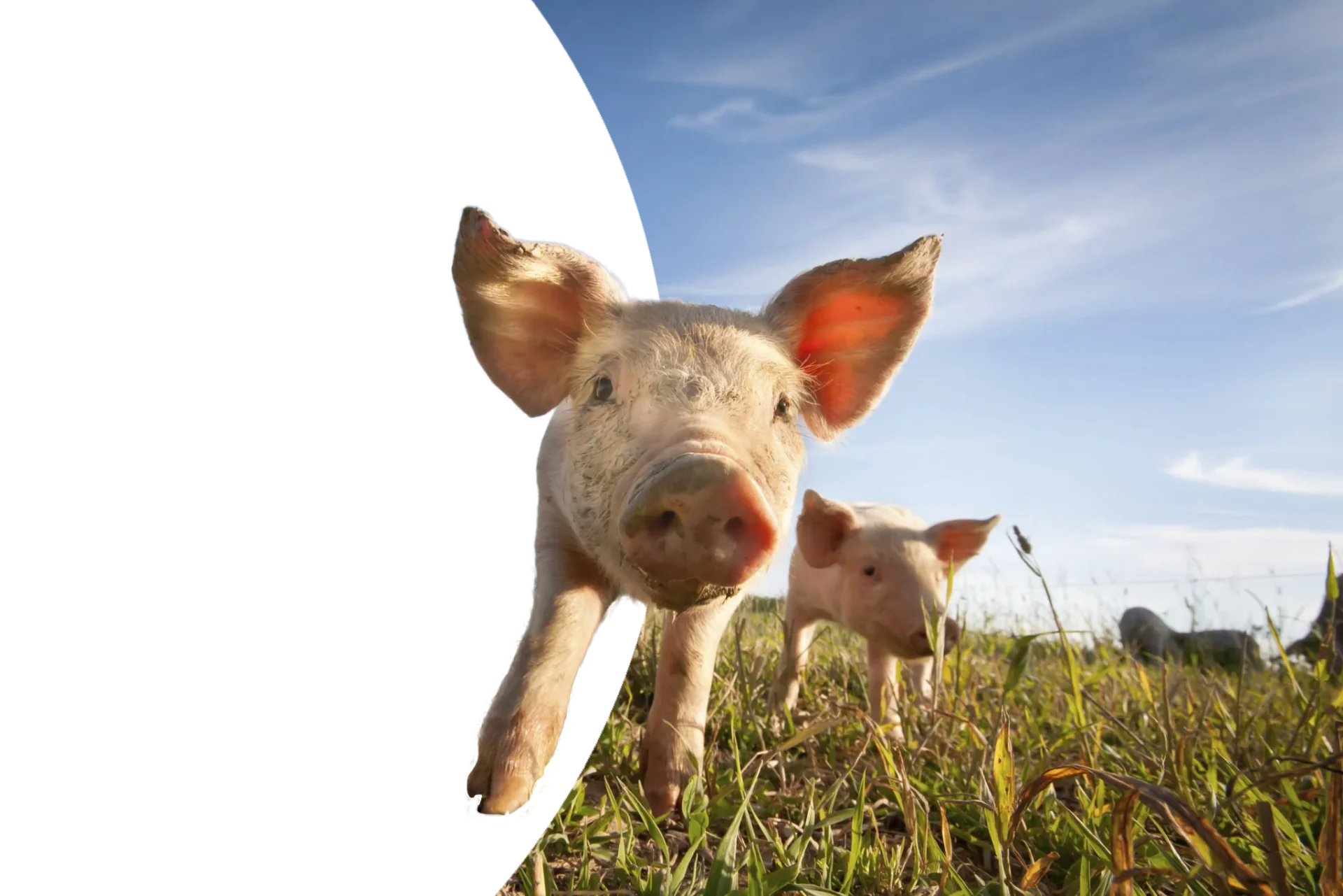
-

Pig Open Field
$2,290.00 Add to cart -

Pig 8 Arm Radial
$3,290.00 Add to cart -

Pig T Maze
$2,290.00 Add to cart -

Piglet T Maze
$2,290.00 Add to cart -

Pig Hebb-Williams Maze
$2,290.00 Add to cart -

Pig Conditioned Place Preference
$2,290.00 Add to cart -

Pig Delayed Non-Match To Sample (DNMS) Task
$2,290.00 Add to cart -

Pig Y-Maze
$1,990.00 Add to cart -

Piglets Removable Y Maze
$1,990.00 Add to cart -

Judgement Bias Apparatus
$1,990.00 Add to cart -

Pig Mirror
$2,290.00 Add to cart -

Pig Foraging Arena
$2,290.00 Add to cart
Pigs Behaviors and Characteristics
Scientific Name: | Sus Scrofa Scrofa |
Family Name: | Suidae |
Habitat: | Can survive in any productive habitat (most cases) |
Weight: | Anywhere from 10 kg to 300 kg or more |
Diet: | Omnivores |
Sexual Maturity: | 3 to 12 months (females) |
Gestation Period: | 112 to 120 days |
Litter size: | 6 to 14 piglets |
Nesting: | During the last 24 hours before the onset of farrowing; the sows begin nest building by rooting the ground to create a depression and building the nest using twigs; grasses; and leaves. |
Herding: | Pigs are very social animals and are often seen in sounders; which typically consist of two or more females and their young ones. Males can often be seen living solitary or in bachelor groups |
Hierarchy: | Dominance hierarchy can form as early as 1 week of age (confined pigs). Piglets develop teat order which once formed remains stable for the same piglet group. |
Communication: | Pigs communicate using vocalization. Rooting is also considered a form of communication. Piglets begin socialization approximately at 5 weeks of age with conspecifics and by 14 weeks of age with other species |
· Pigs have relatively poor vision. They have a panoramic vision of approximately 310° and binocular vision of 35° to 50°.
· Pigs have a highly developed olfactory sense. Sows can detect lower concentrations of smell and pheromones better than boars.
· Pigs have a well-developed hearing sense.
· Pigs lack in sweat glands. Thus, they indulge in wallowing to thermoregulate their body temperatures.
Other behaviors & characteristics
· Pigs are cognitively complex animals. They can indulge in destructive behaviors if bored.
· Pigs have a strong fear of being picked up. However, with regular interactions, they are known to be amenable.
History
Pigs were primarily used for food, though, pig-derived products such as their hides, bones, and bristles were also used for building tools and other products. The domestication of pigs is believed to have taken place around 8500 BC in the Near East. The pigs were introduced into Europe by agriculturalist migrating into northwestern Europe between 5500 and 4200 cal BC. (Caliebe, Nebel, Makarewicz, Krawczak, & Krause-Kyora, 2017; Giuffra et al., 2000; Krause-Kyora et al., 2013)
Interest in pig selection and breeding was mainly for improving their economic value as a food source. By the mid-20th century, pigs began to be considered as an alternative animal model in biomedical research. Initially, domestic farm breeds of pigs were used in research. However, their large size meant extensive husbandry and maintenance requirements leading to more expenses as opposed to the traditional animal models such as rodents. By the late 1940s, the development of minipig breeds was underway. These breeds were developed to be smaller sized, docile and easy to manage. Further, the crossbreeding of minipigs also involved the development of breeds with specific characteristics for biomedical research (Larzul, 2013).
By the early 1980s, pigs gained momentum as a popular animal model, especially as a preclinical model. Their physiologic, anatomic, and pathologic similarities to humans make them an excellent model for human diseases, disorders, and conditions. Additionally, the porcine genome project also facilitated its use as an animal model (Abbott, 2012).
Breeds
Pigs are natives of the Eurasian and African continents. Pigs belong to the Suidae family and fall under the Sus genus. The origins of the domestic pig can be traced to the Eurasian wild boar (Sus scrofa). In the United States, popular domestic farm breeds for research include Duroc, Yorkshire, Landrace, and crossbreeds while miniature breeds include Yucatan mini and micro, Hanford, Sinclair, and Göttingen.
Domestic Farm Breeds
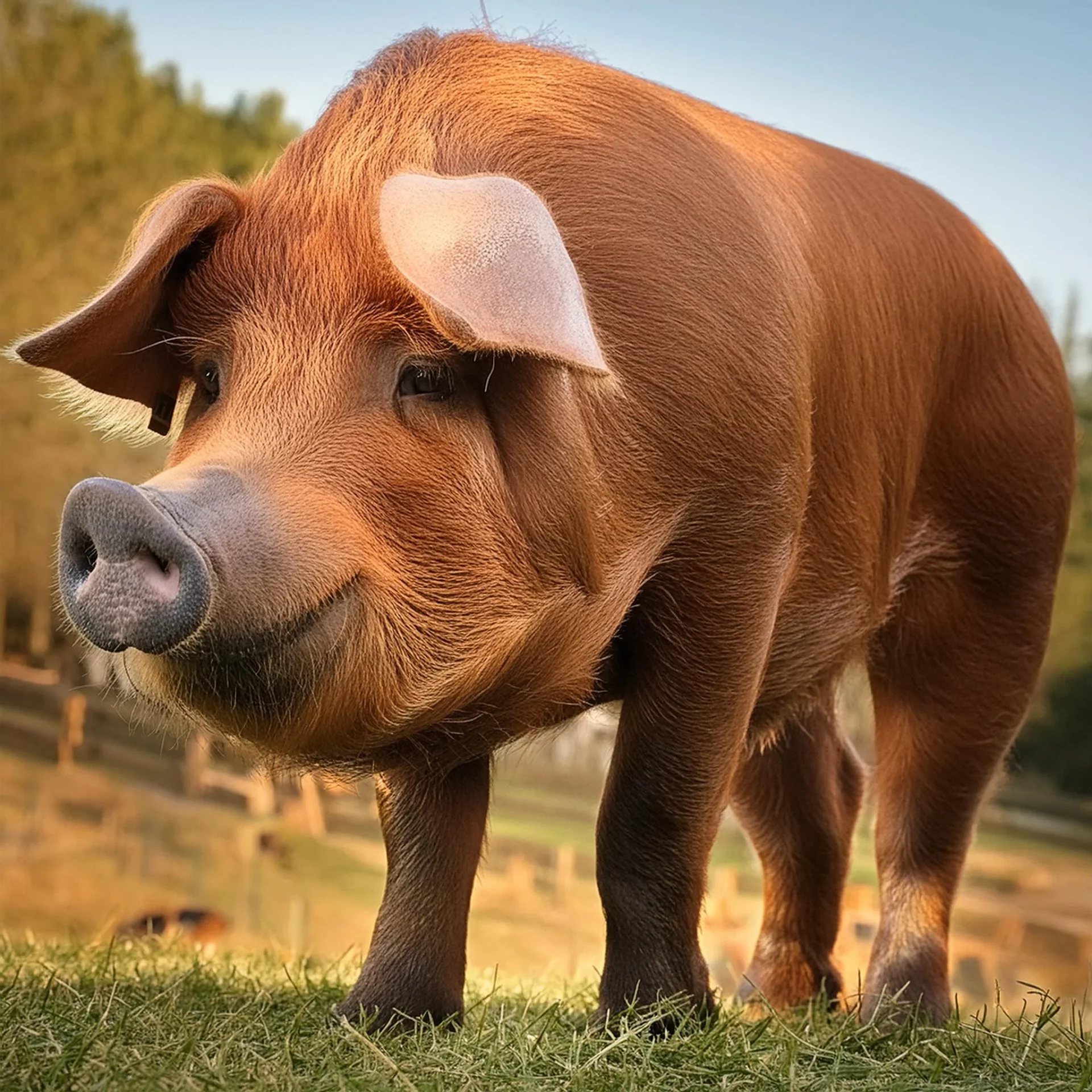
Duroc Pig

Yorkshire Pig
The Yorkshire pig was developed in Yorkshire, Northern England in 1761 as the Large White pig. The breed is a cross between large indigenous white pig of North England and the smaller, fatter, white Chinese pig. Around 1830, the Yorkshire breed was introduced to the United States in the Ohio state. The American Yorkshire pigs are white in color (sometimes with dark areas) and have erect ears, and short pugged noses. The pigs are rough and strong with good adaptability to climate and other ecological factors. Sows are known to have an average litter of 13 piglets.

Landrace Pig
Landrace strain was first developed in Denmark around 1895 as a cross between the native Danish pigs and the Large White from England. The breed was introduced into the United States in the early 1830s. The Landrace pigs have white coloration often with small black spots. The American Landrace pigs are long and lean with a long and narrow head. The ears are large and heavy, drooping forward with the top edges almost parallel to the bridge of a straight nose. Sows of the breed are known for producing plenty of milk and raising large litters.
Miniature Breeds
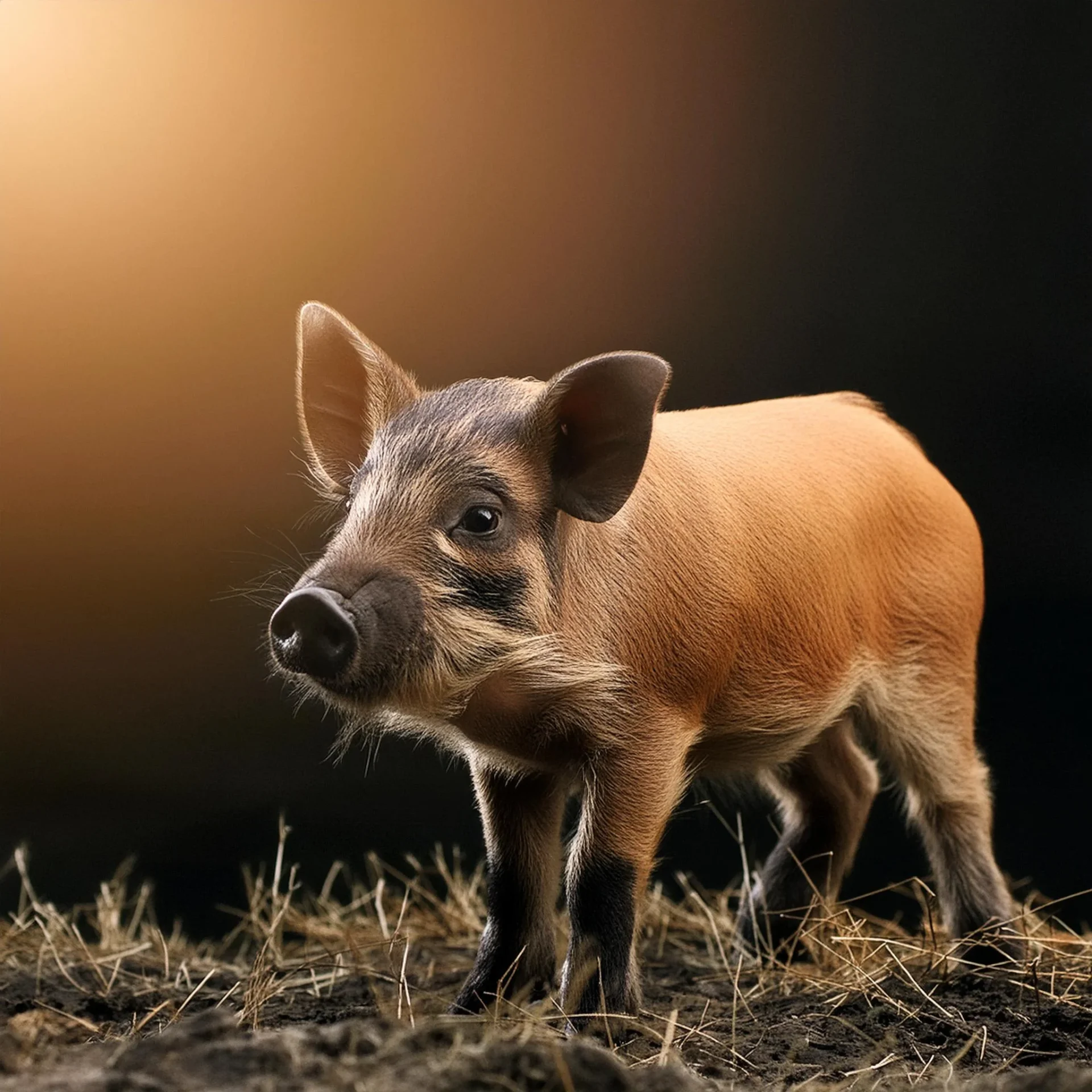
Yucatan Miniature Pig
The parent stock of the Yucatan miniature pigs was obtained from the Yucatan Peninsula of Mexico. The breed was introduced to the United States in 1960. The first micro-sized Yucatan was developed using a small Yucatan boar in the Colorado State University. The breed has a docile nature and adapts well with human interactions. Mature non-obese boars on average can weigh about 83 kg while sows can be about 70 kg, with average height and length of 57 cm and 76 cm, respectively. The breed has highly pigmented color (Slate-gray) and often are hairless or have very little hair. Since the Yucatan miniature pigs are native to the tropical region, intensive management is required for cold weather conditions.
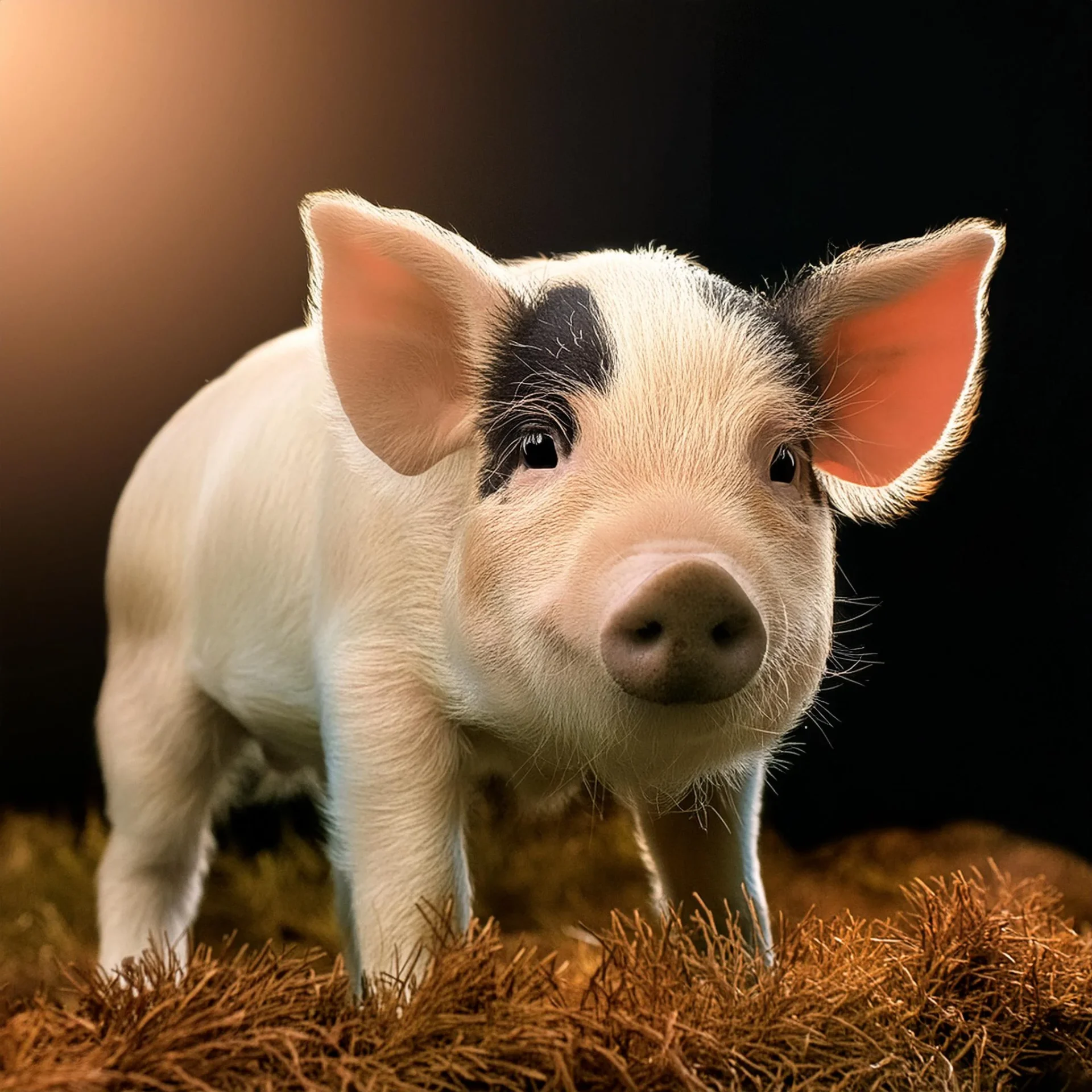
Hanford Miniature Pig
The Hanford miniature breed was developed at the Hanford Labs, Richland, Washington in 1958. The breed was a result of crossing Palouse gilts with a Pittman-Moore boar. Additional reduction in size was obtained by introducing Swamp hog from Louisiana and adding more Pittman-Moore to the mix. Mature pigs can weigh around 75 kg and tend to have less subcutaneous fat in comparison to other breeds. The breed looks much like traditional farm pigs with its white hair coat. Their calm nature makes them well-adapted for laboratory environments.

Sinclair Miniature Pig
The Sinclair miniature breed was developed by crossing four feral breeds at the Hormel Institute at the University of Minnesota in the year 1949. Addition of a Yorkshire boar to the stock resulted in white hair colored pigs. The breed was the first miniature stock to be specifically developed for research. The Sinclair breed has a slow growth rate. The miniatures are available in variations of haircoat colors.
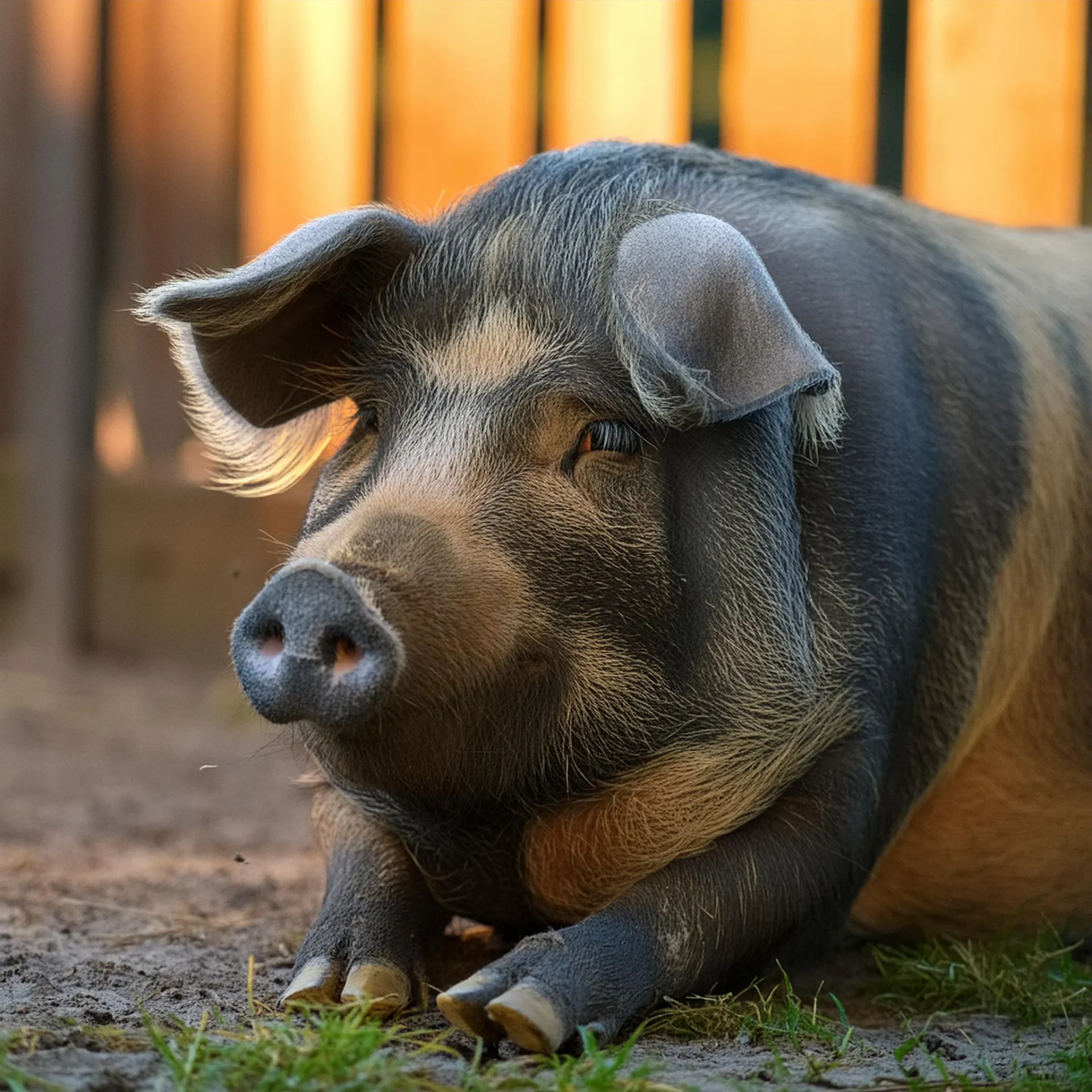
Göttingen Miniature Pig
The Institute of Animal Breeding and Genetics at the University of Göttingen, Germany, began developing of the Göttingen miniatures. The breed was developed by crossbreeding the Minnesota minipig, the Vietnamese pot-bellied pig, and the German Landrace pig. The breed is the smallest of the domestic pig breeds with adult weight around 30 to 40 kgs. The Göttingen pigs are known for their docile nature and well-characterized health status. The breed has white non-pigmented skin.
Training Considerations
Pigs fall in the category of prey animals, and thus are sensitive animals that do require a certain amount of attention to ensure their overall well-being in a laboratory set-up. The following are some considerations to take into account to ensure the animal’s welfare.
- Allow the animals to acclimate to the research environment at least one week prior to any testing. Regular, positive interactions with the pigs make them easy to handle and reduce Care must be taken to prevent any negative interactions with the animals since it will result in increased fear.
- Pigs should be maintained in an enriched environment with materials that are safe and have either of the following qualities: edible (preferably with some nutritional benefits), chewable, investigable and manipulatable.
- Enrichments used in the holding chamber should be clean since pigs will avoid interacting with soiled items.
- Pigs should preferably be maintained in groups given their social nature. However, if they are to be maintained in isolation, the holding chamber should be such that it permits visual, auditory and olfactory interactions with the other animals. Complete social isolation is not recommended since it can significantly affect the animal’s behaviors.
- Appropriate bedding and flooring must be used that either provide a thermoneutral zone or the opportunity to thermoregulate by wallowing or huddling. The right choice of flooring is also essential to ensure that animals do not suffer any discomfort or injuries. Long natural straw is an excellent choice for bedding material.
- Pigs are strong and forceful animals. Holding chambers should be made of sturdy materials and any loose objects such as feeders and waterers should be securely fastened to cages.
- Pigs should not be tethered since it will result in chronic stress.
- Physical restraining of the animals during research should be only done after the animal has acclimated to the device and the handling. Further, it is advisable to keep restraining to a minimum. Restraining devices such as the sling tend to have a calming effect on the animal, and hence such devices are recommended.
- Chemical restraint that offers minimal stress should be used for invasive procedures to prevent negative handling experiences.
- Pigs should not be subjected to forced movement and handling. Allow the subjects to run up and down the aisle at least once a week to reduce stress and make their handling easier. It is also recommended that individual animals are always taken along with a familiar conspecific for research to reduce stress and anxiety.
- Dietary requirements of pigs used as laboratory animals will defer from their farm counterparts. Diets should be adjusted to maintain the size and body condition required for the research.
- Appropriate pain management techniques should be kept in place to avoid any unnecessary discomfort to the animals.
Pigs in Research
Overall, rodents are indispensable in advancing our understanding of basic biological processes, disease mechanisms, and therapeutic interventions, contributing significantly to biomedical and scientific progress.
Strengths and Limitations
Summary
- Pigs are evolutionarily closer to humans. Interest in pigs as animal models peaked in the 18th
- Porcine model is a popular non-rodent model due to its physiologic, anatomic, and pathologic similarities to humans.
- The large size of pigs is comparable to humans and allows the use of human clinical devices.
- Popular domestic breed pigs include Duroc, Yorkshire, Landrace, and crossbreeds.
- Popular miniature breeds include Yucatan mini and micro, Hanford, Sinclair, and Göttingen.
- Miniature pigs are easy to handle and maintain in comparison to the domestic variety. Further, the development of transgenic miniature varieties allows for a more cohesive investigation of human diseases.
- Pigs tend to have large litters which permit reduction of experimental variability.
- Physical or chemical restraining that offers minimal stress to the animals should be used when required.
- Pigs are very social and possess complex cognition. Social isolation, poor holding environments, and negative interactions have a significant effect on the animal’s behaviors.
- Holding environments should be constructed taking into consideration the lack of sweat glands in pigs.
- Dietary requirements of laboratory pigs will require appropriate adjustments to meet the experiment’s requirements.
References
- Abbott, A. (2012). Pig geneticists go the whole hog. Nature, 491(7424):315-6. doi: 10.1038/491315a.
- Almond, G. W. (1996). Research Applications using Pigs. Veterinary Clinics of North America: Food Animal Practice, 12(3), 707–716. doi:10.1016/s0749-0720(15)30394-7
- Armstead, W. M., Riley, J., & Vavilala, M. S. (2013). Dopamine prevents impairment of autoregulation after traumatic brain injury in the newborn pig through inhibition of Up-regulation of endothelin-1 and extracellular signal-regulated kinase mitogen-activated protein kinase. Pediatric Critical Care Medicine, 14(2):e103-11. doi: 10.1097/PCC.0b013e3182712b44.
- Bassols, A., Costa, C., Eckersall, P. D., Osada, J., Sabrià, J., & Tibau, J. (2014). The pig as an animal model for human pathologies: A proteomics perspective. PROTEOMICS – Clinical Applications, 8(9-10), 715–731. doi:10.1002/prca.201300099.
- Brans, T. A., Dutrieux, R. P., Hoekstra, M. J., Kreis, R. W., & du Pont, J. S. (1994). Histopathological evaluation of scalds and contact burns in the pig model. Burns, 20, S48–S51. doi:10.1016/0305-4179(94)90090-6
- Caliebe, A., Nebel, A., Makarewicz, C., Krawczak, M., & Krause-Kyora, B. (2017). Insights into early pig domestication provided by ancient DNA analysis. Scientific Reports,7:44550. doi: 10.1038/srep44550.
- Cooper, D. K. (2012). A brief history of cross-species organ transplantation. Proceedings (Baylor University, Medical Center), 25(1):49-57.
- Cooper, D. K. C., Hara, H., & Yazer, M. (2010). Genetically Engineered Pigs as a Source for Clinical Red Blood Cell Transfusion. Clinics in Laboratory Medicine, 30(2), 365–380. doi:10.1016/j.cll.2010.02.001.
- Doucet, J., Gao, Z. H., MacLaren, L. A., & McAlister, V. C. (2004). Modification of xenoantigens on porcine erythrocytes for xenotransfusion. Surgery, 135(2):178-86.
- Ekser, B., Li, P., & Cooper, D. K. C. (2017). Xenotransplantation: past, present, and future. Current Opinion in Organ Transplantation, 22(6):513-521. doi: 10.1097/MOT.0000000000000463.
- Feng, Z., Mao, Z., Dong, S., & Liu, B. (2016). Protective effect of active perfusion in porcine models of acute myocardial ischemia. Molecular Medicine Reports, 14(4):3581-7. doi: 10.3892/mmr.2016.5665
- Friess, S. H., Ichord, R. N., Owens, K., Ralston, J., Rizol, R., Overall, K. L., …, Margulies, S. S. (2007). Neurobehavioral functional deficits following closed head injury in the neonatal pig. Experimental Neurology, 204(1):234-43.
- Gieling, E. T., Nordquist, R. E., & van der Staay, F. J. (2011). Assessing learning and memory in pigs. Animal Cognition, 14(2):151-73. doi: 10.1007/s10071-010-0364-3. https://link.springer.com/article/10.1007/s10071-010-0364-3
- Giuffra, E., Kijas, J. M., Amarger, V., Carlborg, O., Jeon, J. T., & Andersson, L. (2000). The origin of the domestic pig: independent domestication and subsequent introgression. Genetics, 154(4):1785-91.
- Gutierrez, K., Dicks, N., Glanzner, W. G., Agellon, L. B., & Bordignon, V. (2015). Efficacy of the porcine species in biomedical research. Frontiers in Genetics, 6:293. doi: 10.3389/fgene.2015.00293.
- Hughes, H. C. (1986). Swine in cardiovascular research. Laboratory Animal Science,36(4):348-50.
- Iwase, H., Liu, H., Wijkstrom, M., Zhou, H., Singh, J., Hara, H., …, Cooper, D. K. (2015). Pig kidney graft survival in a baboon for 136 days: longest life-supporting organ graft survival to date. Xenotransplantation, 22(4):302-9. doi: 10.1111/xen.12174.
- Kim, S., Higginbotham, L., Mathews, D., Breeden, C., Stephenson, A., Larsen, C., …, Adams, A. (2017). CD4 Depletion Is Necessary and Sufficient for Long-Term Nonhuman Primate Xenotransplant Survival. [abstract]. American Journal of Transplantation, 17 (suppl 3).
- Kragh, P.M., Nielsen, A.L., Li, J., Du, Y., Lin, L., Schmidt, M., …, Jørgensen, A.L. (2009). Hemizygous minipigs produced by random gene inserti on & handmade cloning express the Alzheimer’s disease-causing dominant mutati on APPsw. Transgenic Research, 18(4):545-58.
- Krause-Kyora, B., Makarewicz, C., Evin, A., Flink, L. G., Dobney, K., Larson, G., …, Nebel, A. (2013). Use of domesticated pigs by Mesolithic hunter-gatherers in northwestern Europe. Nature Communications, 2013;4:2348. doi: 10.1038/ncomms3348.
- Larzul, C. (2013). Pig genetics: insight in minipigs. Bilateral Symposium on Miniature Pigs for Biomedical Research in Taiwan and France., Taïnan, Taiwan. pp.1-6, 2013. <hal-00958583>
- Lee, W., Miyagawa, Y., Long, C., Ekser, B., Walters, E., Ramsoondar, J., …, Hara, H. (2016). Expression of NeuGc on Pig Corneas and Its Potential Significance in Pig Corneal Xenotransplantation. Cornea, 35(1):105-13. doi: 10.1097/ICO.0000000000000635.
- Lelovas, P. P., Kostomitsopoulos, N. G., & Xanthos, T. T. (2004). A comparative anatomic and physiologic overview of the porcine heart. Journal of American Association for Laboratory Animal Science, 53(5):432-8.
- Li, A., Zhang, Y., Liu, Y., & Pan, Z. (2017). Corneal Xenotransplantation From Pig to Rhesus Monkey: No Signs of Transmission of Endogenous Porcine Retroviruses. Transplantation Proceedings, 49(9):2209-2214. doi: 10.1016/j.transproceed.2017.07.018.
- Lind, N. M., Moustgaard, A., Jelsing, J., Vajta, G., Cumming, P., & Hansen, A. K. (2007). The use of pigs in neuroscience: modeling brain disorders. Neuroscience & Biobehavioral Reviews, 31(5), 728–751. doi: 10.1016/j.neubiorev.2007.02.003
- Lunney, J. K. (2007). Advances in swine biomedical model genomics. International Journal of Biological Science, 3(3):179-84.
- Marchant-Forde, J. N., & Herskin, M. S. (2018). Pigs as laboratory animals. Advances in Pig Welfare, 445–475. doi:10.1016/b978-0-08-101012-9.00015-0.
- Millikan, L. E., Hook, R. R., & Manning, P. J. (1973). Immunobiology of melanoma. Gross and ultrastructural studies in a new melanoma model: the Sinclair swine. Yale Journal of Biology and Medicine, 46(5):631-45.
- Misfeldt, M. L., & Grimm, D. R. (1994). Sinclair miniature swine: an animal model of human melanoma. Veterinary Immunology & Immunopathology, 43(1-3):167-75.
- Müller, S., Wanke, R., & Distl, O. (2001). Inheritance of melanocytic lesions and their association with the white colour phenotype in miniature swine. Journal of Animal Breeding & Genetics, 118 275–283. 10.1046/j.1439-0388.2001.00280.x.
- Nielsen, T. R., Kornum, B. R., Moustgaard, A., Gade, A., Lind, N. M., & Knudsen, G. M. (2009). A novel spatial Delayed Non-Match to Sample (DNMS) task in the Göttingen minipig. Behavioral Brain Research, 196(1):93-8. doi: 10.1016/j.bbr.2008.07.019.
- Nunoya, T., Shibuya, K., Saitoh, T., Yazawa, H., Nakamura, K., Baba, Y., & Hirai, T. (2007). Use of Miniature Pig for Biomedical Research, with Reference to Toxicologic Studies. Journal of Toxicologic Pathology, 20(3), 125-132. doi:10.1293/tox.20.125
- Rao, M. J., Schneider, K., Chait, B. T., Chao, T. L., Keller, H., Anderson, S., …, Acharya, A. S. (1994). Recombinant hemoglobin A produced in transgenic swine: structural equivalence with human hemoglobin A. Artificial Cells, Blood Substitutes, and Immobilization Biotechnology, 22(3):695-700. DOI: 10.3109/10731199409117900
- Rixen, D., Raum, M., Holzgraefe, B., Sauerland, S., Nagelschmidt, M., & Neugebauer, E. A. M. (2001). A PIG HEMORRHAGIC SHOCK MODEL: OXYGEN DEBT AND METABOLIC ACIDEMIA AS INDICATORS OF SEVERITY. Shock, 16(3), 239–244. doi:10.1097/00024382-200116030-00012
- Ryan, M. C., Sherman, P., Rowland, L. M., Wijtenburg, S. A., Acheson, A., Fieremans, E., …, McGuire, S. A. (2018). Miniature pig model of human adolescent brain white matter development. Journal of Neuroscience Methods, 296:99-108. doi: 10.1016/j.jneumeth.2017.12.017.
- Seaton, M., Hocking, A., & Gibran, N. S. (2015). Porcine Models of Cutaneous Wound Healing. ILAR Journal, 56(1), 127–138. doi:10.1093/ilar/ilv016
- Smith, A. C., & Swindle, M. M. (2006). Preparation of Swine for the Laboratory. ILAR Journal, 47(4), 358-363. doi:10.1093/ilar.47.4.358.
- Steffensen, L. B., Poulsen, C. B., Shim, J., Bek, M., Jacobsen, K., Conover, C. A., …, Oxvig, C. (2015). Myocardial and Peripheral Ischemia Causes an Increase in Circulating Pregnancy-Associated Plasma Protein-A in Non-atherosclerotic, Non-heparinized Pigs. Journal of Cardiovascular Translation Research, 2015 Dec;8(9):528-35. doi: 10.1007/s12265-015-9656-y.
- Sullivan, T. P., Eaglstein, W. H., Davis, S. C., & Mertz, P. (2001). The pig as a model for human wound healing. Wound Repair & Regeneration, 9(2):66-76.
- Summerfield, A., Meurens, F., & Ricklin, M. E. (2015). The immunology of the porcine skin and its value as a model for human skin. Molecular Immunology, 66(1):14-21. doi: 10.1016/j.molimm.2014.10.023.
- Suzuki, Y., Yeung, A. C., & Ikeno, F. (2011). The representative porcine model for human cardiovascular disease. Journal of Biomedicine & Biotechnology, 2011;2011:195483. doi: 10.1155/2011/195483.
- Swindle, M. M., Makin, A., Herron, A.J., Clubb, F. J. Jr, & Frazier, K. S. (2012). Swine as models in biomedical research and toxicology testing. Veterinary Pathology, 49(2):344-56. doi: 10.1177/0300985811402846.
- Taniguchi, S., & Cooper, D. K. (1997). Clinical xenotransplantation: past, present and future. Annals of Royal College of Surgeons of England, 79(1):13-9.
- Velander, P., Theopold, C., Bleiziffer, O., Bergmann, J., Svensson, H., Feng, Y., & Eriksson, E. (2009). Cell Suspensions of Autologous Keratinocytes or Autologous Fibroblasts Accelerate the Healing of Full Thickness Skin Wounds in a Diabetic Porcine Wound Healing Model. Journal of Surgical Research, 157(1), 14–20. doi:10.1016/j.jss.2008.10.001.
- Velander, P., Theopold, C., Hirsch, T., Bleiziffer, O., Zuhaili, B., Fossum, M., … Eriksson, E. (2008). Impaired wound healing in an acute diabetic pig model and the effects of local hyperglycemia. Wound Repair and Regeneration, 16(2), 288–293. doi:10.1111/j.1524-475x.2008.00367.x
- Vincent-Naulleau, S., Le Chalony, C., Leplat, J.-J., Bouet, S., Bailly, C., Spatz, A., … Geffrotin, C. (2004). Clinical and Histopathological Characterization of Cutaneous Melanomas in the Melanoblastoma-Bearing Libechov Minipig Model. Pigment Cell Research, 17(1), 24–35. doi:10.1046/j.1600-0749.2003.00101.x
- Voelckel, W. G., Raedler, C., Wenzel, V., Lindner, K. H., Krismer, A. C., Schmittinger, C. A., …, Königsrainer, A. (2003). Arginine vasopressin, but not epinephrine, improves survival in uncontrolled hemorrhagic shock after liver trauma in pigs. Critical Care Medicine, 31(4):1160-5.
- Wang, B., Yu, B., Karim, M., Hu, H., Sun, Y., McGreevy, P., …, Brand-Miller, J. (2007). Dietary sialic acid supplementation improves learning and memory in piglets. American Journal of Clinical Nutrition, 85(2):561-9.
- Yang, D., Wang, C. E., Zhao, B., Li, W., Ouyang, Z., Liu, Z., …, Li, X. J. (2010). Expression of Huntington’s disease protein results in apoptotic neurons in the brains of cloned transgenic pigs. Human Molecular Genetics, 19(20):3983-94. doi: 10.1093/hmg/ddq313.
- Zaidi, A., Schmoeckel, M., Bhatti, F., Waterworth, P., Tolan, M., Cozzi, E., …, Friend, P. (1998). Life-supporting pig-to-primate renal xenotransplantation using genetically modified donors. Transplantation, 65(12):1584-90.

